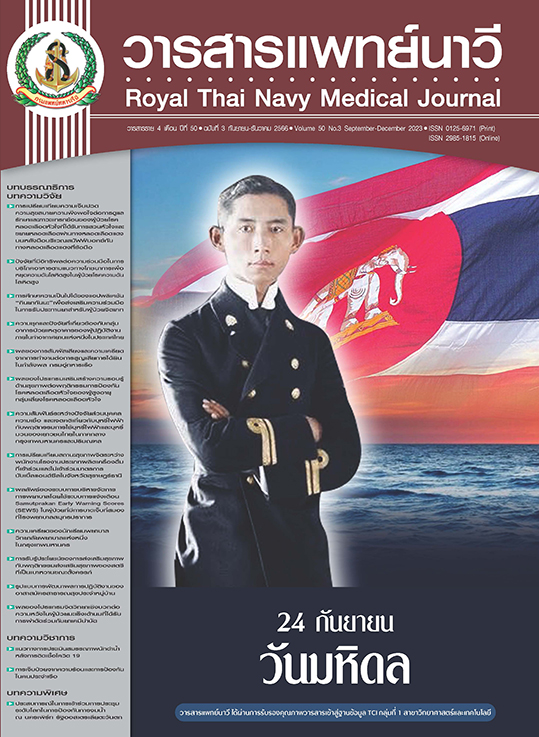Prevalence and Associated Factors of Sick Building Syndrome’s Symptoms among Workers in an Airport, Thailand
Main Article Content
Abstract
Nowadays, the number of people living and working in buildings with closed ventilation systems is increasing. Past studies showed that the worldwide population was affected by "Sick Building Syndrome (SBS)", especially those working in office buildings and high-rise buildings. This cross-sectional study is the first study to examine the prevalence of SBS among workers in airport buildings and study the associated factors in many dimensions. There were 402 workers participating in this study. Data were collected using the questionnaire “MM 040 NA” in Thai language version with content validity validated based on an index of item objective congruence (IOC) 0.67 - 1 and the Cronbach alpha coefficient of 0.62 coupled with the indoor air quality annual report. The relationship was analyzed using multiple logistic regression statistics. The prevalence of SBS was 29.4%. The associated factors of SBS are female, younger than 40 years old, having bachelor's degree or higher in educational level, involved with more than half of work time using a screen, work stress, and unpleasant smell. Improving the environment and operations as well as diagnosing SBS are key to solving the problem. Studying the impact of SBS on performance remains to be an important area for future studies.
Article Details

This work is licensed under a Creative Commons Attribution-NonCommercial-NoDerivatives 4.0 International License.
References
Jafari MJ, Khajevandi AA, Najarkola SAM, Yekaninejad MS, Pourhoseingholi MA, Omidi L, et al. Association of sick building syndrome with indoor air parameters. Tanaffos 2015;14(1):55-62.
EPA. Indoor air facts No. 4 (revised): sick building syndrome. EPA-Air Radiat (6609J), Res Dev 1991:1-4.
WHO. Indoor air pollutants: exposure and health effects. Copenhagen: Regional Office for Europe; 1983. p. 1-42.
Burge PS. Sick building syndrome. Occup Environ Med 2004;61(2):185-90.
Redlich CA, Sparer J, Cullen MR. Sick-building syndrome. Lancet 1997;349(9057):1013-6.
Jones AP. Indoor air quality and health. Atmospheric environment 1999;33(28):4535-64.
Kannirun M, Surawattanasakul V, Rattananupong T, Jiamjarasrangsi W. Prevalence and association of indoor environmental factors and sick building syndrome among workers of Army Medical Department headquarter, Bangkok. Journal of the Royal Thai Army Nurses 2022;23(3):197-205. (in Thai).
Ekpanyaskul C. Prevalence and associated factors of sick building syndrome among office workers in Bangkok. [Master’s Thesis, Faculty of Medicine]. Chulalongkorn University; 2003. (in Thai).
Dhungana P, Chalise M. Prevalence of sick building syndrome symptoms and its associated factors among bank employees in Pokhara Metropolitan, Nepal. Indoor air 2020;30(2):244-50.
Andersson K. Epidemiological approach to indoor air problems. Indoor air 1998;8(S4):32-9.
Airports of Thailand Public Company Limited (AOT). Report of indoor air quality Mae Fah Luang-Chiang Rai International Airport. Bangkok: Faculty of Engineering, KMUTT; 2022. (in Thai).
Singapore Standard SS 554. Indoor air quality for airconditioned buildings. [Internet]. [cited 2022 January 10]. Available from: http://www.thailab.co.th/cms/picture/std/20210501061030.pdf.
Tonprom C. Relationship between sick building syndrome and indoor air quality in Klang hospital. [Master’s Thesis, Faculty of Engineering]. Chulalongkorn University; 2010. (in Thai).
Azuma K, Ikeda K, Kagi N, Yanagi U, Osawa H. Prevalence and risk factors associated with nonspecific building-related symptoms in office employees in Japan: relationships between work environment, indoor air quality, and occupational stress. Indoor Air 2015;25(5):499-511.
Gupta S, Khare M, Goyal R. Sick building syndrome-a case study in a multistory centrally air-conditioned building in the Delhi city. Building and Environment 2007;42(8):2797-809.
Santos IS, Griep RH, Alves MGM, Goulart A, Lotufo P, Barreto S, et al. Job stress is associated with migraine in current workers: the Brazilian Longitudinal Study of Adult Health (ELSA-B rasil). Eur J Pain 2014;18(9):1290-7.
Sayan HE, Dülger S. Evaluation of the relationship between sick building syndrome complaints among hospital employees and indoor environmental quality. Med Lav 2021;112(2):153-61.
Surawattanasakul V, Sirikul W, Sapbamrer R, Wangsan K, Panumasvivat J, Assavanopakun P, et al. Respiratory symptoms and skin sick building syndrome among office workers at university hospital, Chiang Mai, Thailand: associations with indoor air quality, AIRMED Project. Int J Environ Res Public Health 2022;19(17):10850.
Leung L, Persily A, Mandin P, Bahnfleth WP, Sekha C, Kipen H, et al. ASHRAE position document on indoor carbon dioxide. Georgia: Technology Parkway; 2022. p. 1-15.
Jompook P, Siritarungsri B, Sosome B. Self-management model for asthma patients of secondary community hospitals in Saraburi province. Royal Thai Navy Medical Journal 2022;49(1):60-78. (in Thai).
Bundasak T, Thiankumsri K, Udonsat S. Burnout prevention among nursing instructors. Royal Thai Navy Medical Journal 2022;49(1):183-97. (in Thai).

